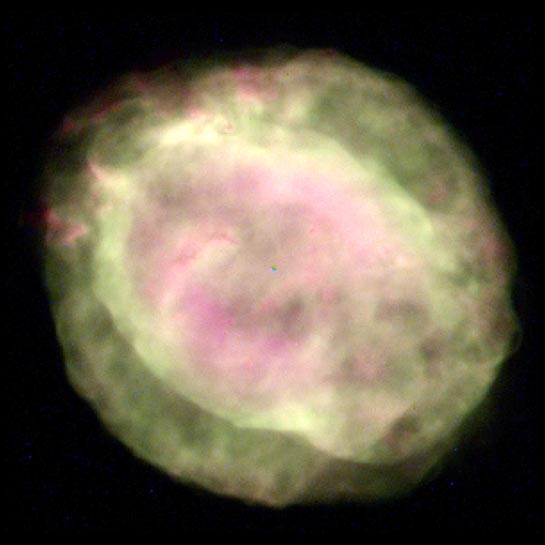
Planetary Nebula
RA 19hr 43m 58.022s Dec -14° 09' 13.44"
Sagittarius
6000 light-years
10.0
22" x 15"
March 10, 1997
Robert Rubin (Ames Research Center), Reginald Dufour & Matt Browning (Rice University), Patrick Harrington (U of Maryland), & NASA
March 19, 1998
2015 Image: N1531
ABOUT THIS IMAGE:
This Wide Field and Planetary Camera 2 image of NGC 6818 shows two distinct layers of gas (with dust): a spherical outer region and a brighter, vase-shaped interior 'bubble.' Astronomers believe that a fast wind - material propelled by radiation from the hot central star - is creating the inner elongated shape. The central star of the planetary nebula appears as a tiny blue dot. The material in the wind is traveling so fast that it smashes through older, slower-moving stellar debris, causing a 'blowout' at both ends of the bubble (lower right and upper left).
NGC 6818 is in the constellation Sagittarius at a distance of about 6000 light-years. It has a diameter of about 0.5 light-year. The Hubble telescope observation was taken March 10, 1997 by the Wide Field and Planetary Camera 2.
This is a composite of images taken in 3 filters: Halpha is red, Hbeta is blue, and [O III] (doubly ionized oxygen) 5007 is green. As a result of the longer exposure time at Hbeta, the central star of the planetary nebula appears blue. We see a roughly spherical outer envelope as well as a brighter vase-shaped interior "bubble". Astronomers believe that a fast wind from the hot central star is creating the elongated shape and in fact has caused a "blowout" at the two ends of the major axis (lower right and upper left).
This nebula looks like a twin of NGC 3918, another planetary nebula (PN) that has been imaged by the Hubble telescope. The structure of NGC 3918 is remarkably similar to that of NGC 6818 - it has an outer spherical envelope, an inner brighter elongated bubble, and it also shows a blowout orifice at one end of the major axis in the bottom right-hand corner. By finding and studying such similar objects, it is hoped that crucial details can be learned about the evolutionary life history of planetary nebulae. One could call this "comparative PNology".
From Wikipedia:
The Little Gem Nebula or NGC 6818 is a planetary nebula located in the constellation of Sagittarius. It has magnitude 10 and oval diameter of 15 to 22 arcseconds with a 15th magnitude central star. It was discovered by William Herschel in 1787. NGC 6818 is located in the constellation of Sagittarius (The Archer), roughly 6000 light-years away from Earth. The glow of the cloud is just over half a light-year across.
When stars like the Sun are near end of life, they send their outer layers into space to create glowing clouds of gas, a planetary nebulae. This ejection of mass is uneven, and planetary nebulae can have complex shapes. NGC 6818 shows knotty filament-like structures and distinct layers of material, with a bright and enclosed central bubble surrounded by a larger, more diffuse cloud.
Scientists
believe that the stellar wind from the central star propels the outflowing
material, forming the elongated shape of NGC 6818. As this stellar wind
moves through the slower-moving cloud it creates particularly bright spots
in the bubble's outer layers.